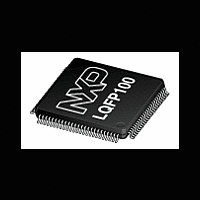LPC2361_62 NXP Semiconductors, LPC2361_62 Datasheet - Page 17

LPC2361_62
Manufacturer Part Number
LPC2361_62
Description
The LPC2361/2362 microcontrollers are based on a 16-bit/32-bit ARM7TDMI-S CPU with real-time emulation that combines the microcontroller with up to 128 kB of embedded high-speed flash memory
Manufacturer
NXP Semiconductors
Datasheet
1.LPC2361_62.pdf
(64 pages)
NXP Semiconductors
LPC2361_62
Product data sheet
7.7.1 Features
7.8 Fast general purpose parallel I/O
example, a bidirectional port requires one stream for transmit and one for receive. The
source and destination areas can each be either a memory region or a peripheral, and
can be accessed through the AHB master.
Device pins that are not connected to a specific peripheral function are controlled by the
GPIO registers. Pins may be dynamically configured as inputs or outputs. Separate
registers allow setting or clearing any number of outputs simultaneously. The value of the
output register may be read back as well as the current state of the port pins.
LPC2361/2362 use accelerated GPIO functions:
•
•
•
•
•
•
•
•
•
•
•
•
•
•
•
•
Two DMA channels. Each channel can support a unidirectional transfer.
The GPDMA can transfer data between the 8 kB SRAM and peripherals such as the
two SSP, and I
Single DMA and burst DMA request signals. Each peripheral connected to the
GPDMA can assert either a burst DMA request or a single DMA request. The DMA
burst size is set by programming the GPDMA.
Memory-to-memory, memory-to-peripheral, peripheral-to-memory, and
peripheral-to-peripheral transfers.
Scatter or gather DMA is supported through the use of linked lists. This means that
the source and destination areas do not have to occupy contiguous areas of memory.
Hardware DMA channel priority. Each DMA channel has a specific hardware priority.
DMA channel 0 has the highest priority and channel 1 has the lowest priority. If
requests from two channels become active at the same time the channel with the
highest priority is serviced first.
AHB slave DMA programming interface. The GPDMA is programmed by writing to the
DMA control registers over the AHB slave interface.
One AHB master for transferring data. This interface transfers data when a DMA
request goes active.
32-bit AHB master bus width.
Incrementing or non-incrementing addressing for source and destination.
Programmable DMA burst size. The DMA burst size can be programmed to more
efficiently transfer data. Usually the burst size is set to half the size of the FIFO in the
peripheral.
Internal four-word FIFO per channel.
Supports 8-bit, 16-bit, and 32-bit wide transactions.
An interrupt to the processor can be generated on a DMA completion or when a DMA
error has occurred.
Interrupt masking. The DMA error and DMA terminal count interrupt requests can be
masked.
Raw interrupt status. The DMA error and DMA count raw interrupt status can be read
prior to masking.
All information provided in this document is subject to legal disclaimers.
2
S interfaces.
Rev. 5 — 25 October 2011
Single-chip 16-bit/32-bit MCU
LPC2361/62
© NXP B.V. 2011. All rights reserved.
17 of 64














